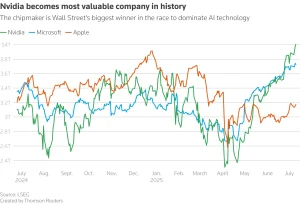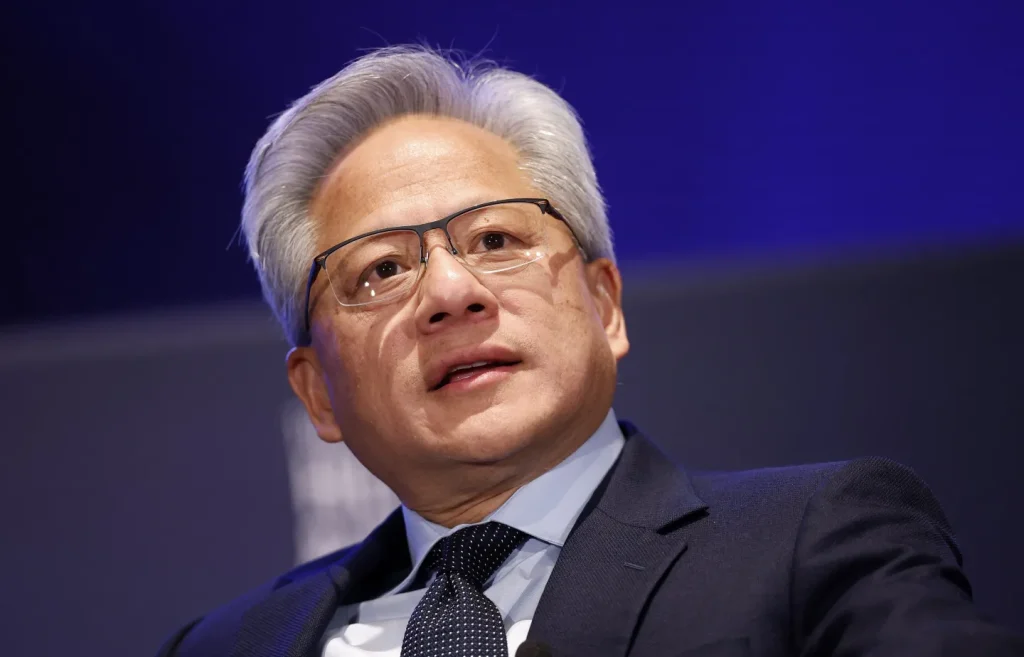Nvidia has officially crossed another major milestone, ending Thursday’s trading session with a staggering market valuation of $4.004 trillion, marking the first time the tech giant has closed above the $4 trillion threshold. This achievement further consolidates Nvidia’s position as the most valuable semiconductor firm in history and underscores its central role in powering the global artificial intelligence (AI) revolution.
The company’s shares closed 0.75% higher at $164.10, extending its massive lead over Apple and Microsoft and reflecting robust investor confidence in Nvidia’s long-term growth potential amid a global AI arms race.
AI-Fueled Growth Catapults Nvidia Past Tech Titans
Nvidia’s meteoric rise has been nothing short of historic. In June 2023, the chipmaker became the seventh company in history to hit a $1 trillion market cap. Astonishingly, it tripled that value in just over a year—an ascent that far outpaced the trajectories of Apple and Microsoft when they achieved similar milestones.
Currently, Microsoft holds the position of the second-most valuable company in the U.S., with a market capitalization of $3.73 trillion, while Apple, once the undisputed leader, has seen its market value drop to $3.17 trillion after a 15% stock decline in 2025.
Nvidia’s valuation now exceeds the combined market value of all publicly traded companies in the United Kingdom, further highlighting its global financial dominance.
Strategic Importance in the AI Gold Rush
At the core of Nvidia’s financial surge is its dominance in high-performance AI processors, particularly Graphics Processing Units (GPUs), which have become indispensable for training and running large-scale AI models. These chips power everything from OpenAI’s ChatGPT to Microsoft’s Azure AI infrastructure and Meta’s data centers.
Tech giants including Microsoft, Alphabet, Amazon, Meta, and Tesla are scrambling to build out massive AI capabilities—and they all rely heavily on Nvidia’s cutting-edge hardware. The company’s H100 and H200 GPUs are considered the gold standard in AI computing, and orders are often backlogged for months.
This surging demand has catapulted Nvidia into the role of gatekeeper for next-gen AI development, with many experts calling its processors the “picks and shovels” of the AI gold rush.
Valuation Still Reasonable Despite Historic Rally
Despite its extraordinary growth, Nvidia’s stock valuation remains within a reasonable range compared to its earnings potential. As of Thursday, shares traded at about 33 times projected earnings, which is actually below the company’s five-year average P/E ratio of 41, according to data from LSEG (London Stock Exchange Group).
This suggests that although the stock has soared in price, investors believe Nvidia’s earnings will continue to rise significantly, driven by ongoing AI infrastructure expansion worldwide.
In comparison, many high-growth tech companies often trade at much higher multiples without Nvidia’s consistent revenue streams and profitability.

Apple Lags as AI Integration Stalls
While Nvidia continues to set records, Apple has struggled to maintain investor enthusiasm in 2025. The iPhone maker’s shares have fallen by 15% year-to-date, reflecting investor concerns about the company’s slow integration of artificial intelligence features into its ecosystem of products and services.
Unlike rivals such as Microsoft and Google, Apple has yet to unveil a clear AI roadmap that resonates with both consumers and developers. This strategic hesitation has raised questions about its ability to remain competitive in an era where intelligent automation and AI assistants are rapidly becoming standard features.
Meanwhile, Microsoft, which has deeply integrated OpenAI technologies into its suite of enterprise tools, continues to benefit from enterprise adoption of AI software.
Geopolitical Tensions Could Complicate Nvidia’s Outlook
Despite its strong financials and market dominance, Nvidia is not immune to risks—particularly geopolitical ones. The company’s AI chips have become entangled in the ongoing U.S.–China trade standoff, as Washington has imposed export restrictions on Nvidia’s most advanced chips destined for Chinese firms.
These export controls are part of broader U.S. efforts to curb China’s access to critical technologies that could bolster its military or surveillance capabilities. In response, Nvidia has attempted to design lower-performance chips that comply with regulations while still serving its Chinese customer base.
However, analysts warn that escalating trade tensions or new restrictions could disrupt Nvidia’s global sales and supply chains, especially given China’s growing interest in building a domestic AI chip industry to reduce reliance on U.S. technology.
“Trade tensions and tariffs are a significant risk, as is the threat of increased competition,” noted Ipek Ozkardeskaya, senior analyst at Swissquote Bank, in a client advisory. “As AI adoption accelerates, some demand may shift toward lower-cost alternatives, particularly for less demanding AI applications.”
Competitive Pressures Begin to Mount
Nvidia’s dominance has not gone unnoticed. Rivals such as AMD (Advanced Micro Devices) and Intel are ramping up their efforts to produce competing AI chips. Meanwhile, big tech players like Google and Amazon are developing custom silicon for internal use, which could marginally reduce their reliance on Nvidia in the long run.
That said, building chips at Nvidia’s level of performance and efficiency is an enormously complex task, and many experts believe the company has at least a two- to three-year lead in core AI computing technology.
Even with potential in-house solutions, the sheer scale of AI workloads ensures that demand for Nvidia’s chips will remain high—at least in the near to medium term.
A Defining Moment in Financial and Technological History
Nvidia’s $4 trillion milestone marks more than just a financial achievement—it signifies a shift in the hierarchy of global innovation. From its humble beginnings as a graphics card manufacturer focused on gaming, the company has reinvented itself as the most vital player in artificial intelligence infrastructure.
Its story mirrors the evolution of the tech industry itself, where hardware, software, and AI models converge in a race to reshape how people live, work, and interact with technology.
Wall Street has taken notice, rewarding Nvidia not just for its past performance, but for its pivotal role in the future of computing.
Conclusion: Nvidia’s Ascent Reflects a Changing World
Nvidia’s unprecedented market surge to over $4 trillion in value reflects broader investor confidence in the transformative potential of AI—and the company’s role at the center of that transformation. As the technology continues to evolve and become embedded in everything from healthcare to transportation, Nvidia’s processors are likely to remain essential.
Whether or not the company can sustain its dominance amid rising global competition and regulatory hurdles remains to be seen. But for now, Nvidia is not just winning the AI race—it’s defining it.











